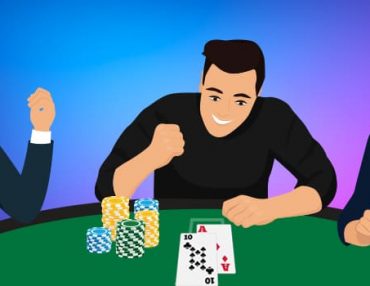The Soft 17 rule in blackjack is one of the most important rules to remember when you learn the basics of blackjack, not just because it completely changes the way the dealer plays, but because it impacts the house edge and your own playing strategy too.
What is Soft 17 in blackjack?
In literal terms, Soft 17 is another way of describing a blackjack hand worth 17 which includes an Ace, where the Ace counted either as 1 or 11. A Soft hand cannot bust if you take one card more.
In contrast, a hard hand is simply one without an Ace, or which includes an Ace but it can bust if another card is taken.
Soft 17 can be made in various ways. The Ace-6 hand is the most common Soft 17 hand that most blackjack players will know, but you can also make Soft 17 with 3 or more cards, so long as the Ace is counted as 11 or 1.

Examples include the Ace-3-3 hand and Ace-Ace-2-4. Blackjack hands like these are called ‘soft’ because you cannot bust, and you can still improve your hand value (or make it worse!) by taking more cards.
Because of this, we play Soft 17 very differently to how we play Hard 17 (which you would always stand). In a classic 8 deck game, we either hit or double Soft 17, depending on the dealer’s upcard and the type of rules we face.
But Soft 17 is more than just a type of blackjack hand. It’s an even bigger deal because it features in the second most important rule in blackjack – aptly named the Soft 17 Rule.
The Soft 17 rule explained
As a player, you can do virtually whatever you like with your hand, but the dealer must act according to a simple rule. In every blackjack game, the dealer either stands on Soft 17 or higher, or hits Soft 17, which means they can only stand on Hard 17, plus any 18 or more.
After the number of decks used and the payout odds for hitting Blackjack itself, whether a dealer stands or hits on Soft 17 is the next most important rule. You can tell which rule a game uses because it is always written on the table next to the Blackjack odds.

In the UK, all blackjack games are S17, so the dealer draws to 16 and stands on all hands worth 17. The Soft 17 rule is mainly found in America, although even then, it is not employed at every table.
Unfortunately, blackjack terms can be very confusing. You might think that S17 is short hand for the Soft 17 rule, but it’s not. S17 means ‘Dealer Stands on Soft 17’ and H17 means ‘Dealer Hits on Soft 17’. So when I refer to tables with the Soft 17 rule as H17, you’ll know what I mean!
What difference does it make to the dealer?
If the dealer must hit on a Soft 17 hand, it has two main impacts on their chances. Firstly, hitting Soft 17 increases their chance of busting. But it also increases their chances of making a better hand too.
Those two may seem incompatible, but they’re not. Either they bust their hand, make a similar total to what they already had, or make a better total. The dealer’s chance of busting increase slightly by 0.4% but their odds of making 18 or more go up by around 0.80%. Overall then, the Soft 17 rule is more favourable to the dealer’s hand than to the player.
What effect does the Soft 17 rule have on the house edge?
Clearly an S17 game is better for blackjack players and an H17 game is better for the house, but how big a difference does it make to playing blackjack over the long run?
Assuming all other rules are the same, the difference between an H17 game and an S17 game to players is a whopping 0.2% in house edge over the long run. To put that small number in perspective, typical European blackjack tables in online casinos have a house edge of only 0.7%, so 0.2% is a meaningful amount.
If you stake £10,000 in a year of blackjack play, you’d get £20 more in returns at a S17 table than the equivalent H17 table. In a game of razor thin margins, every pound matters.

But the Soft 17 rule is only part of the story, and in reality you would never get two tables with identical rules bar the S17/H17. Games with H17 will have different combinations of rules such as NDAS, and you need to take the whole picture into account when sizing up a table.
When you choose your blackjack table, it may even be possible to find a game which uses the Soft 17 rule but has a lower overall house edge, thanks to other rules in place that benefit the player.
When you play blackjack online at PlayOJO, it’s easy to check the house edge, but in a live game it can be difficult to know the house edge and every rule in play. But all other things being equal, it’s usually better to choose the S17 game.
How to adjust your strategy for the Soft 17 rule?
Let’s look at the changes you need to make to basic strategies in blackjack in games with 4 or more decks, as it’s the most widely played format these days.
In a multi deck blackjack game, there are 3 main situations where the optimal basic strategy decision depends on whether the dealer has to hit or stand on Soft 17. All of these basic strategy scenarios involve playing the hand more aggressively by doubling down.
If your table offers Blackjack’s Surrender rule, there are 3 more situations where the strategy charts recommend you should adjust your basic blackjack strategy.

Single deck blackjack games are a dying breed but if you’re lucky enough to find one, the advice in Soft 17 basic strategy blackjack charts changes again. This time there are just 2 adjustments to your basic strategy. Both arise when you have specific variations of 18 when the dealer’s upcard is an Ace. You should hit Ace-7 v Ace instead of standing, and you should split a pair of Nines v Ace when you would normally stand.
Counting cards and the Soft 17 rule
If you are good at counting cards, you’ll have a pretty good idea of how many high and low cards are left in the deck. This allows you to change your bet size and hand strategy decision to exploit those moments when the deck is favourable.
Card counting is an advanced blackjack skill and there are many variables to consider, not least what the dealer does with Soft 17. If you have 11 when the dealer’s upcard is an Ace, for example, you can double depending on the True Count. In a S17 game, the True Count has to be +1 or higher, but in a H17 game, it only needs to be –1 or higher.
There are several situations like this in the Illustrious 18 counting strategy, where the required True Count to deviate from standard basic strategy is lower for H17 games.
Conclusion
The Soft 17 rule features heavily in blackjack rules and is plastered all over every table felt, but in reality it is never used on its own to increase the house edge, and the bottom line is that there is minimal impact on playing strategy. As long as you’re aware how Soft hands work and the special exceptions to basic strategy, you won’t ever need to pay it much attention.


















